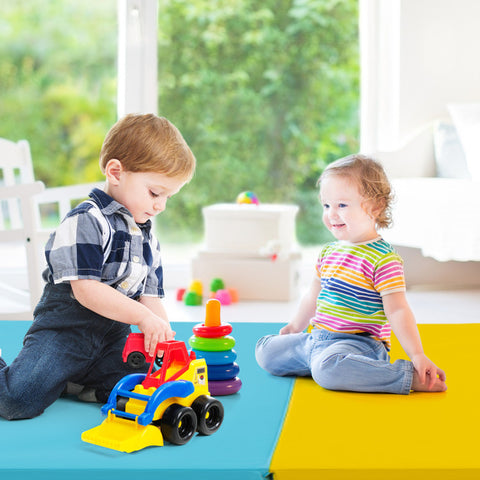News
Common Gymnastics Mat Mistakes to Avoid for Safety and Durability
A gymnastics mat is one of the most essential pieces of equipment for gymnasts, martial artists, and fitness enthusiasts. Whether you're training at home or in a professional gym, using your mat correctly ensures both safety and longevity. However, many athletes unknowingly make mistakes that can lead to injuries, damage, and reduced mat lifespan. In this guide, we’ll cover the most common gymnastics mat mistakes to avoid and how to properly maintain your mat for long-term use.

Choosing the Wrong Type of Gymnastics Mat
Not all gymnastics mats are created equal. Using the wrong mat for your training can increase the risk of slips, falls, and inadequate support.
-
Thin mats for high-impact training: If you practice tumbling, vaulting, or aerial stunts, a thin mat won’t provide enough shock absorption, leading to potential joint strain.
-
Too soft for stability: A mat that is too soft can cause balance issues, making it harder to land safely. High-density foam mats offer better support for movements requiring stability.
-
Using yoga mats for gymnastics: Yoga mats are not designed for impact-heavy activities and lack the necessary durability and grip.
Tip: Always select a mat that matches your activity. For tumbling, use a high-density foam mat, and for general floor exercises, a medium-density mat works best.
Improper Placement of the Mat
Where and how you place your gymnastics mat significantly affects its safety and effectiveness.
-
Uneven surfaces: Placing a mat on an uneven or slippery floor increases the risk of falls and missteps.
-
Gaps between mats: If you're using multiple mats, ensure they are properly aligned and secured to prevent tripping hazards.
-
Insufficient coverage: If the mat is too small for your movements, you risk landing off the mat, increasing injury chances.
Tip: Always set up your mat on a flat, non-slip surface and secure multiple mats together with Velcro strips or connectors.
Skipping Regular Cleaning and Maintenance
A dirty or damaged mat not only looks bad but also harbors bacteria and loses its effectiveness over time.
-
Not cleaning sweat and dirt: Over time, moisture and bacteria buildup can lead to an unhygienic training environment.
-
Ignoring minor tears and cracks: Small tears can grow larger, affecting the mat’s cushioning and durability.
-
Leaving mats exposed to moisture: Storing your mat in a damp area can lead to mold growth and material breakdown.
Tip: Wipe down your mat with a mild disinfectant after each use and store it in a dry, cool place. Inspect for tears and repair them immediately with mat repair tape.
Using Shoes or Sharp Objects on the Mat
Gymnastics mats are designed for barefoot or soft footwear use. Wearing inappropriate shoes or using sharp objects can cause permanent damage.
-
Shoes with hard soles: Running or jumping on the mat with regular shoes can cause indentations and reduce the mat’s lifespan.
-
Using weights or sharp tools: Heavy gym equipment or pointed objects can puncture or tear the mat’s surface.
Tip: Train barefoot or use soft-soled gymnastics shoes. Keep sharp objects away from your mat to prevent unnecessary damage.
Incorrect Storage Practices
Improperly storing your gymnastics mat can lead to warping, creases, and material breakdown.
-
Folding when not necessary: Some mats are designed to be rolled, not folded. Folding can cause permanent creases that make the mat uneven.
-
Leaving mats in direct sunlight: Prolonged exposure to sunlight can weaken the foam and vinyl covering, making it prone to cracking.
-
Stacking heavy objects on top: Placing heavy items on your mat can cause compressions that affect the foam’s resilience.
Tip: Follow the manufacturer’s storage recommendations. Roll the mat if required, and store it in a cool, dry place away from direct sunlight.
Ignoring Weight and Impact Limits
Each gymnastics mat has a weight and impact threshold. Overloading the mat beyond its capacity can lead to faster wear and tear.
-
Multiple users on a single mat: Some mats are designed for solo use and may not handle the pressure of multiple people.
-
Performing extreme impact moves on soft mats: Certain moves, like flips and landings, require mats with high-density foam to absorb the force properly.
Tip: Check the weight and impact capacity of your gymnastics mat before use. For high-impact training, opt for crash mats or landing pads.
Conclusion
Avoiding common gymnastics mat mistakes is key to ensuring safety, improving performance, and extending the lifespan of your mat. By choosing the right mat, setting it up properly, and maintaining it regularly, you create a safer and more effective training environment. Whether you're a beginner or an experienced athlete, taking care of your gymnastics mat helps prevent injuries and enhances your overall training experience.

